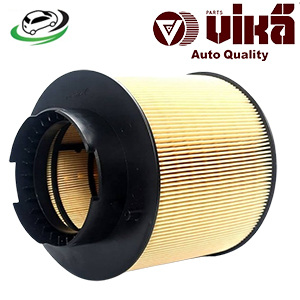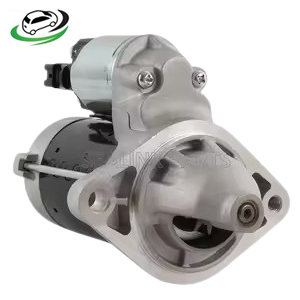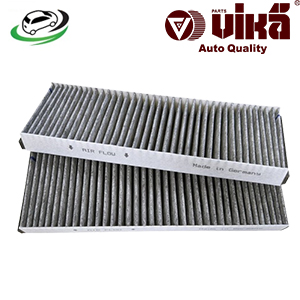-15%
Get Cabin Filter Set AUDI C6 A6 FWD V6 3.2L/ C6 A6 Quattro V6 3.2L / C6 A6 Quattro V8 4.2L 4F0898438
The cabin filter, also known as the air cabin filter or passenger compartment filter, is a crucial component of a vehicle’s HVAC (Heating, Ventilation, and Air Conditioning) system. It plays a significant role in maintaining air quality inside the vehicle, enhancing comfort, and ensuring the efficient operation of the HVAC system. This guide provides a comprehensive overview of the cabin filter, including its function, types, construction, signs of failure, replacement, and maintenance.
What is a Cabin Filter?
A cabin filter is a specialized filter located within the vehicle’s HVAC system. Its primary function is to trap dust, pollen, and other airborne particles before they enter the cabin. This helps to keep the air inside the vehicle clean and free from pollutants, allergens, and unpleasant odors. By filtering out contaminants, the cabin filter improves the overall air quality and contributes to a healthier and more comfortable driving experience.
Functions of the Cabin Filter
The cabin filter performs several essential functions:
- Air Purification: The cabin filter removes particulate matter such as dust, dirt, pollen, and soot from the incoming air. This helps to prevent these contaminants from entering the passenger compartment and ensures that the air inside the vehicle is clean and breathable.
- Odor Reduction: Some cabin filters are equipped with activated carbon layers or other odor-absorbing materials. These filters help to eliminate unpleasant odors from outside sources, such as exhaust fumes, smoke, and industrial pollution, providing a more pleasant driving environment.
- Defogging: A clean cabin filter ensures that the HVAC system can effectively control the humidity and temperature inside the vehicle. This helps to prevent fogging of the windows and maintains clear visibility, especially in adverse weather conditions.
- HVAC System Protection: By trapping contaminants before they reach the HVAC system’s components, the cabin filter helps protect the system from damage and clogging. This contributes to the efficient operation and longevity of the HVAC system.
Construction of the Cabin Filter
The construction of a cabin filter typically involves the following components:
- Filter Media: The filter media is the material used to capture airborne particles. Common types of filter media include:
- Fiberglass: Basic cabin filters often use layers of fiberglass to capture large particles. While effective, they may not filter out smaller contaminants or odors.
- Activated Carbon: Some cabin filters incorporate activated carbon, which has a porous structure that adsorbs odors, gases, and volatile organic compounds (VOCs).
- HEPA (High-Efficiency Particulate Air): HEPA filters are designed to capture very fine particles, including pollen, mold spores, and dust mites. They provide a higher level of filtration compared to standard filters.
- Filter Frame: The filter frame provides structural support and ensures that the filter media stays in place. It is usually made from plastic or cardboard and is designed to fit securely into the filter housing within the HVAC system.
- Seals and Gaskets: Seals and gaskets around the filter edges prevent air from bypassing the filter media. They ensure that all incoming air passes through the filter and is properly cleaned before entering the cabin.
- Housing: The filter housing is the compartment within the HVAC system where the cabin filter is installed. It is designed to hold the filter securely and direct the airflow through the filter media.
Types of Cabin Filters
Cabin filters come in various types, each designed to meet specific needs and preferences:
- Standard Cabin Filters: These filters typically use fiberglass media to capture larger particles such as dust and pollen. They offer basic filtration and are suitable for general use.
- Activated Carbon Cabin Filters: These filters are equipped with a layer of activated carbon to absorb odors and gases. They are ideal for reducing unpleasant smells and improving air quality in areas with high levels of pollution.
- HEPA Cabin Filters: HEPA filters provide a higher level of filtration by capturing very fine particles, including allergens and microorganisms. They are beneficial for individuals with allergies or respiratory conditions.
- Electrostatic Cabin Filters: Electrostatic filters use an electrostatic charge to attract and capture particles. They offer efficient filtration and are often washable and reusable.
- Hybrid Cabin Filters: Hybrid filters combine multiple types of filter media, such as activated carbon and HEPA, to provide comprehensive air purification. They offer enhanced filtration for both particulate matter and odors.
Signs of a Failing Cabin Filter
A failing or clogged cabin filter can affect the performance of the HVAC system and air quality inside the vehicle. Common signs of a failing cabin filter include:
- Reduced Airflow: If the cabin filter becomes clogged with debris, it can restrict airflow through the HVAC system. This may result in reduced ventilation and weak airflow from the vents.
- Unpleasant Odors: A dirty or clogged cabin filter may fail to effectively remove odors, leading to unpleasant smells inside the vehicle. This can include odors from outside sources, such as exhaust fumes or mold.
- Foggy Windows: A failing cabin filter can impact the HVAC system’s ability to regulate humidity and temperature. This may lead to foggy or hazy windows, especially in humid or rainy conditions.
- Increased Dust: If the cabin filter is not functioning properly, you may notice an increase in dust and debris inside the vehicle. This can be a sign that the filter is not effectively trapping particulate matter.
- Allergy Symptoms: If you experience increased allergy symptoms, such as sneezing, itching, or respiratory discomfort, it may be due to a clogged cabin filter that is not adequately filtering allergens.
Replacing the Cabin Filter
Replacing the cabin filter is a straightforward process that can typically be performed as part of routine vehicle maintenance. The steps for replacing a cabin filter are as follows:
- Locate the Filter: The cabin filter is usually located behind the glove compartment or under the dashboard. Refer to the vehicle’s owner’s manual for specific instructions on locating the filter.
- Remove the Glove Compartment (if necessary): In some vehicles, it may be necessary to remove the glove compartment to access the cabin filter. Follow the manufacturer’s instructions to remove any screws or clips securing the glove compartment.
- Remove the Old Filter: Carefully remove the old cabin filter from its housing. Be cautious of any debris that may fall out during the removal process.
- Install the New Filter: Insert the new cabin filter into the housing, ensuring that it is properly aligned and securely seated. Follow any specific instructions provided by the filter manufacturer.
- Reassemble the Glove Compartment: If you removed the glove compartment, reattach it by securing any screws or clips that were removed.
- Test the System: Turn on the HVAC system and check for proper airflow and air quality. Ensure that the new filter is functioning correctly and that there are no issues with ventilation or odors.
Maintaining the Cabin Filter
Proper maintenance of the cabin filter helps ensure optimal performance and longevity. Consider the following tips for maintaining your cabin filter:
- Regular Replacement: Follow the manufacturer’s recommended replacement interval for the cabin filter. This is typically every 12,000 to 15,000 miles or once a year, but it may vary based on driving conditions and usage.
- Check for Debris: Periodically inspect the cabin filter for signs of debris or clogging. If you notice any issues, replace the filter promptly to maintain air quality and HVAC system performance.
- Avoid Contaminants: Minimize exposure to contaminants, such as construction dust or pollen, by avoiding driving in areas with heavy pollution. This helps extend the life of the cabin filter.
- Professional Inspection: Have the cabin filter and HVAC system inspected by a professional mechanic during routine maintenance or if you notice any issues with air quality or ventilation.
Choosing the Right Cabin Filter
When selecting a cabin filter, consider the following factors:
- Vehicle Compatibility: Ensure that the cabin filter is compatible with your vehicle’s make, model, and year. Refer to the vehicle’s owner’s manual or consult with a professional for the correct filter specifications.
- Filter Type: Choose a filter type that meets your needs, such as standard, activated carbon, HEPA, or hybrid. Consider factors such as air quality preferences, allergy concerns, and driving conditions.
- Quality and Brand: Opt for high-quality cabin filters from reputable brands to ensure reliable performance and durability. Quality filters offer better filtration and longer service life.
- Price and Value: Compare prices and features to find a cabin filter that offers good value for money. While cost is a factor, prioritize quality and performance to ensure optimal air quality.
Follow us on Facebook for more parts.



